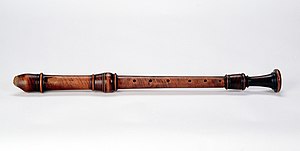Tenor recorder
| Part of a series on |
| Musical instruments |
|---|

Thetenor recorderis a member of therecorderfamily. It has the same form as asoprano(or descant) recorder and analto(or treble) recorder, but it produces a lower sound than either; a still lower sound is produced by thebass recorderandgreat bass recorder.
The tenor recorder, like the soprano recorder, is tuned in C, but is pitched an octave lower. Because of its larger size, many tenors havekeysto make it easier to play the lowest C and C♯,and occasionally D and D♯.
Inmodern notation,the tenor is written at sounding pitch, unlike most of the other recorder sizes, which (except sometimes the alto) are written an octave lower or higher than they sound.[1]
History[edit]
In the Baroque there was a notable lack of the tenor recorder in C,[citation needed]which featured in consort music of the Renaissance, and which forms an important part of the modern recorder playing movement.[citation needed]Instead there existed an alto recorder in D, or "Voiceflute",which was said to be the instrument closest in character to the human voice.[citation needed]In the 18th century, in German-speaking countries, the tenor recorder was namedQuartflöte(fourth flute), after the interval it forms below the ordinary recorder (alto) in F. Confusingly, the same name was used for the soprano recorder in C, apparently because it forms the same interval above the alto in G. At the same time, the English and French equivalents, "fourth flute" and "flute du quatre", meant a recorder a fourth higher than the alto in F—that is, an instrument with B♭as its lowest note.[1]
Innovations[edit]
More recently, the tenor recorder has become the subject of experimentation into modern "harmonic" recorders, so called because of their in-tune harmonics.[2]Nick Tarasov and Joachim Paetzold started experimenting with "harmonic" recorders in the 1930s, with the goal to "strengthen the original characteristics of the recorder and minimize the weakness of standard models".[3]Contemporary models such as the Helder Tenor manufactured byMollenhauerand the Ehlert Tenor produced byMoeckare harmonic recorders as well.[4][5][failed verification]The tenor recorder has also been subject to other variations such as the Breukink-Slide-Recorder,[6]and the moveable-block systems of the Helder Tenor and Strathmann-flute.[7]
Repertoire[edit]
Notably, the soprano recorder has the largest work for a solo wind instrument in European history,Der Fluyten Lust-hofcomposed byJacob van Eyck.[8][clarification needed]Much of the repertoire of the Baroquetraversois commonly adapted onto the tenor recorder.[citation needed]Additionally the tenor recorder has been included in many contemporary ensemble works, such asHindemith:Abendkonzert aus Plöner Musiktagfor SAT ensemble, and the "Music for Recorders" as edited byBenjamin Britten,[full citation needed]among other contemporary works.
References[edit]
- ^abLasocki 2001.
- ^Froehlich n.d.,36-37.
- ^Anon. 2004.
- ^Mollenhauer Recorders 2020.
- ^Moeck n.d.
- ^Froehlich n.d.,45–46.
- ^Froehlich n.d.,45.
- ^Wind 1984,178.
Sources
- Anon. 2004. "Harmonische Blockflöten: Die Geschichte einer neuen Blockflöten-Generation: Nik Tarsasov hält Rückblick und Bestandsaufnahme".Windkanal2:15.
- Froehlich, Susanne. n.d. "The New Potential of a 21st Century Recorder" (Dissertation).[full citation needed].
- Lasocki, David. 2001. "Recorder".The New Grove Dictionary of Music and Musicians,second edition, edited by Stanley Sadie and John Tyrrell. London: Macmillan Publishers.
- Moeck. n.d. "Blockflöten für Könner – 5443 Ehlert".moeck.com (accessed 2 July 2020).
- Mollenhauer Recorders. 2020. "Helder Evo Tenor recorder in rosewood".Mollenhauer.com (accessed 10 April 2020).
- Wind, Thiemo. 1984. "Der Fluyten Lust-hof: Erste vollstandig kommentierte Gesamtausgabe, herausgegeben von Winfried Michel und Hermien Teske (Winterthur, Amadeus Verlag, 1984)".Tijdschrift van de Vereniging voor Nederlandse Muziekgeschiedenis34, No. 2:178–83doi:10.2307/939015JSTOR939015ISSN0042-3874
Further reading[edit]
- Alker, Hugo. 1963. "The Tenor Recorder: Its Development, Special Characteristics and Repertoire", with additions and amendments by Edgar Hunt.The Consortno. 20 (July): 166–73.
- Baines, Anthony C. 1967.Woodwind Instruments and Their History,third edition, with a foreword by SirAdrian Boult.London: Faber and Faber. Reprinted with corrections, 1977. This edition reissued, Mineola, New York: Dover Publications, Inc., 1991, and reprinted again in 2012.ISBN978-0-486-26885-9.
- Bowman, Peter. 1995. "The Birth of a Truly Contemporary Recorder".Recorder Magazine15, No. 4 (November): 126–27.
- Griscom, Richard W., and David Lasocki. 2013.The Recorder: A Research and Information Guide,third edition. Routledge Music Bibliographies. Routledge.ISBN9781135839321.
- Praetorius, Michael. 1619a.Syntagmatis Musici Michaelis Praetorii C. Tomus Secundus De Organographia.Wolfenbüttel: Elias Holwein, in Verlegung des Autoris.
- Praetorius, Michael. 1619b.Syntagmatis Musici Michaelis Praetorii C. Tomus Tertius.Wolfenbüttel: Elias Holwein.
- Rose, Pete. 1996. "A New Recorder for New Music".American Recorder37, No. 4 (September): 18–20.
- Sachs, Curt. 1913.Real-Lexikon der Musikinstrumente, zugleich ein Polyglossar für das gesamte Instrumentengebiet.Berlin: Julius Bard.
